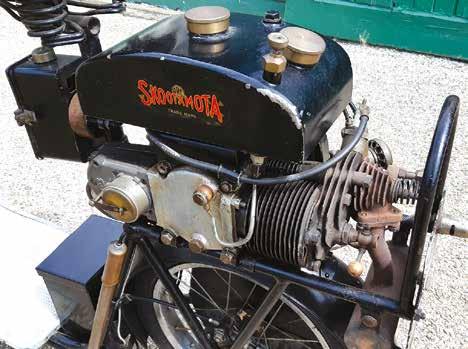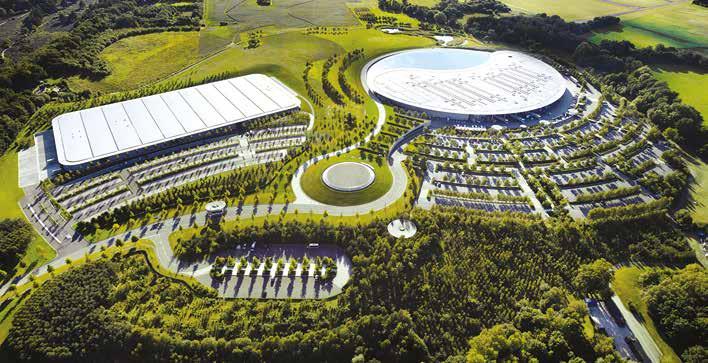
6 minute read
ABC in three
Jack Emerson on the 399cc ABC he rode in the 1920 Victory Handicap race at Brooklands

Advertisement

In the March-April Bulletin, we described Jack Emerson’s epic tortoise and hare race in the Victory Handicap on 10 April, 1920. The winning machine became the basis for ABC’s first post-war offering to the public. An example of this motorcycle can be found in the Clubhouse at Brooklands.
During 2015, the engine was being rebuilt and while it was on the bench several people remarked that it looked
ABC’s first motor vehicle was the 1919 Skootamota pioneered by Gilbert Campling. Granville Bradshaw was initially opposed to it, but later claimed he invented the scooter when it found sales success.
Earlier this year we described how Jack Emmerson won the first race back at Brooklands after World
War One on an ABC. Martin Gegg looks at the history of ABC through three of the motorcycles in the Museum Collection.
Words: Martin Gegg Photos: Brooklands Museum Collection
like an early aero engine. They are not far wrong as Bradshaw was collaborating with Sopwith designing and making aircraft engines during WW1. This engine owes much to its aero cousins in the form of lightweight components and relative simplicity. For the members of the Motorcycle Team who maintain the bike, it continues to reveal some of the eccentric brilliance of Bradshaw.
This motorcycle, together with the little ABC Skootamota and the Zenith Gradua, represents the heritage of ABC which along with Bradshaw played a significant part in the engineering legacy of Brooklands.
The story of ABC starts in 1912 when Ronald Louis Charteris, a pioneer aviator founded the All British Engine Company. This company was born out of a collaboration with Walter Lawson Adams, a Southampton-based manufacturer of marine engines. A 21-year old Granville Bradshaw joined the company as a designer, co-incidentally their last name initials then spelt ABC, and they designed and built aircraft engines which were tested on a vehicle named the Wind Bus that can be seen in some early photographs of the site.
The new company was based within the Brooklands Circuit and was neighbours with aircraft manufacturers and race tuners. Very soon, Bradshaw was asked to design some improved parts for Les Bailey’s Douglas motorcycle. Bradshaw helped him take two 350cc records and win the 150- mile Junior TT in 1912.
By 1913, ABC had manufactured a 500cc motorcycle engine and collaborated with the Collier Brothers of Matchless and Frederick Barnes at Zenith who were asked to design frames. This was to spark a long friendship and collaboration between Brooklands neighbours Barnes and Bradshaw, later resulting in the 1922 Zenith Gradua which sits in the Clubhouse and is powered by a Bradshaw-designed oil-cooled engine.
ABC began building bikes in relatively large numbers and in 1914 the company separated its aviation business, with the motorcycle division being renamed ABC Road Motors (1914). This was a pivotal moment for many manufacturers as they moved to support the War Office after August 1914. ABC had already begun the move from Brooklands to a new location in Hersham before the Royal Flying Corps had forced the relocation of all Brooklands
The Skootamota’s 125cc single-cylinder engine is effectively half of a flat-twin designed by Bradshaw and mounted directly over the rear wheel.

based companies during the first week of August. They were able to continue making motorcycles until 1916 while Bradshaw concentrated on designing aero engines and auxiliary motors for pumps and generators. Bradshaw’s insatiable appetite for innovation did not stop him working on improvements to the motorcycle and in 1916 he had developed a 2½ hp model with a leaf-sprung front
suspension powered by a 250cc ABC Firefly
generator engine.
A consignment of 3hp machines was also manufactured for the Egyptian Government. However, the ship was sunk before reaching its destination, with the loss of all motorcycles. The first motor vehicle built by ABC in Hersham after WW1 was the 1919 Skootamota. The driving force behind this was Gilbert Campling. It used half of a miniature flat-twin engine designed by Bradshaw and built in numbers for the Air Ministry. Bradshaw is quoted as being opposed to the project, but happily claimed to have invented ‘the scooter’ when it became a success. Production moved a few months later to other premises, with around 3200 Skootamotas having been sold by 1922. The Museum’s example is one of the updated models with overhead valves.
Ten days after armistice in 1918, Bradshaw registered the design of a completely new motorcycle. Legend has it that Bradshaw designed and built the prototype in 11 days following a wager with Tom Sopwith. The example at Brooklands is from the original production run by Sopwith in 1920. The 398cc overhead valve flat-twin includes
an integral four-speed gearbox, which is another innovation that would not be seen in common use until at least 20 years later. The machine also features a duplex loop frame with leaf springs front and rear, electric lighting and functional drum brakes, and it was hailed at the time as one of the most advanced motorcycles. However, the rapid development had a price, when technical faults in the

A flat-twin engine designed by Bradshaw and producing 3½hp propels the Zenith Gradua. It uses oil cooling, which was advanced for the period.

ABC Motors continued production at its Hersham site until 1970 and the buildings were then demolished in 2016 to make way for a supermarket development.


The McLaren Technology Centre continues the search for new ideas and innovation that began at Brooklands. Brooklands was a melting pot of engineering innovation. Competition in the marketplace, in the air and on the racetrack stimulated innovation and engineering excellence. Individuals and companies working in close proximity were easily able to collaborate officially and unofficially to drive forward the joint understanding of their industries. This thirst for excellence continues today as we reach out beyond the sky into space, and on the racetrack as we look beyond fossil fuels to the challenges machine came to haunt them. None were insurmountable, but Bradshaw had already moved on to other projects. This included designing a range of innovative oil-cooled engines, one of which can be seen in the Brooklands Zenith Gradua.
ABC entered a somewhat chaotic period. Despite its innovative design, high production costs made the motorcycle unsustainable. Following a restructuring of the company, the aircraft part of the business came under newly formed Hawker Engineering, a company set up following the demise of Sopwith Aviation.
Meanwhile, the Skootamota, oil-cooled engines and 398cc model generated a profit under licencing agreements, the latter being made in France by Gnome et Rhône. ABC then moved into production of cars as well as motorcycles while continuing with the manufacture of aircraft. This carried on until Vickers acquired all the share capital in 1955. Manufacturing at the Hersham site under the ABC Motors brand was continued by Vickers right up to 1970 when the manufacturing was moved to its Crayford plant.
The site which originally encompassed Hersham Lodge, a 19th century mansion, remained as an industrial site until August 2016 when the buildings were demolished
Into the future
to make way for a supermarket. of the future. Such clusters of innovation and engineering excellence can still be found in Surrey such as satellite companies around Guildford University’s Surrey Space Centre, The McLaren Group and a host of specialist engineering companies such as T&G Engineering in West Byfleet all building on the legacy of Brooklands. The Museum continues to build on this legacy by inspiring people to shape their future through inventiveness expertise and a sense of adventure.




